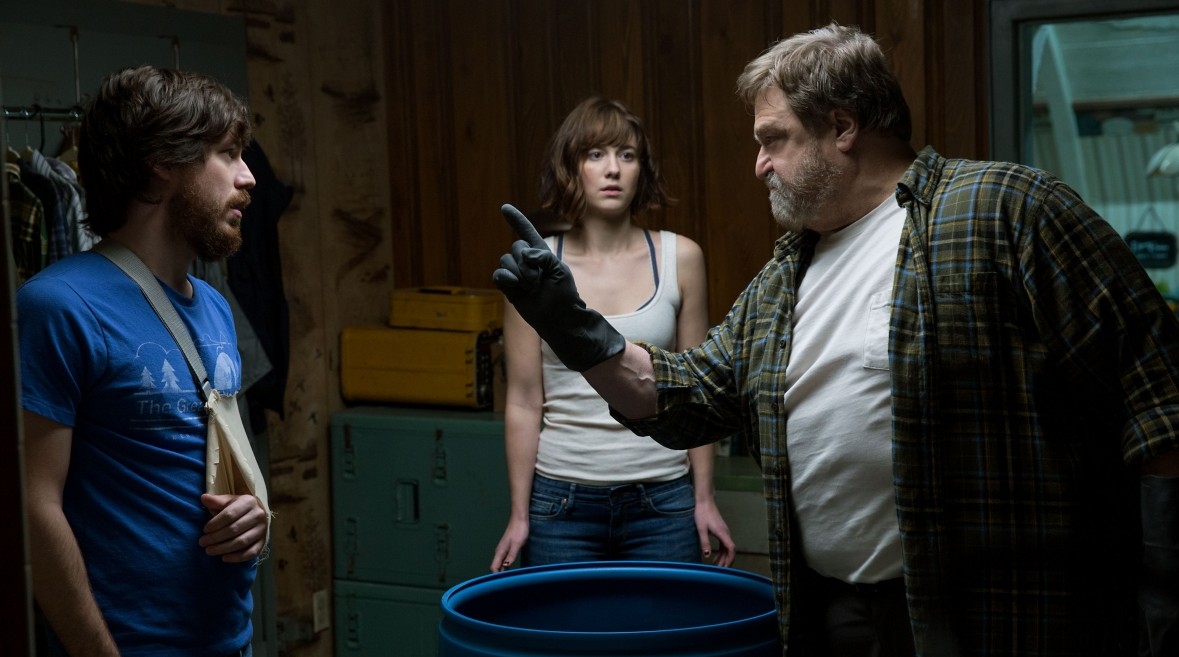Thrillers today have seemingly no new ground to tread. If you attempt to imagine the most fearsome or twisted scenario, the most intensely action packed violence you can, odds are it has already been portrayed. Still, it’s hard to see the public, yet to tire from the continuous barrage of superhero movies, ever getting bored of watching these endless formulaic narratives. After all, Jurassic World and The Force Awakens – both sequels of a sort to movies made decades earlier – topped the charts for the highest grossing films last year. So what is it then about the most financially successful movies that really keeps people coming back?
Since its recent release, viewers have been widely speculating about the new J.J. Abrams produced 10 Cloverfield Lane. It’s message – and who’s to say that there absolutely has to be one – is entirely elusive. Any interpretation of the two monsters in the film – one being the actual beast and the other Goodman’s character – as allegorical is likely completely invented. But it’s often ambiguity and room for invention that captivate audiences much more than explicit moral or political judgments.
Josh Campbell and Matthew Stuecken wrote the film as parallel rather than sequential to Cloverfield (2008), in which a similar beast runs rampant through Manhattan, captured on personal cameras which act as the viewer’s only set of eyes. Beyond the monster takeover, which comprises only a small portion of the latter film, the two have little in common, at least in terms of plot.
10 Cloverfield Lane opens to Michelle being run off the road whilst dodging calls from her fiancé, voiced by Bradley Cooper, only to awaken to find herself chained up in an underground bunker built by Howard, an eccentric and short-tempered man, and his boyish neighbour, Emmett. The three exist peacefully, if a little tensely, in the bunker together for an unspecified amount of time – though the close-up shots of the deterioration of Michelle’s nail polish seem to suggest only a matter of weeks – until Emmett and Michelle make a terrifying discovery about Howard’s past. Michelle is then faced with the decision to remain with one monster in the bunker or face another unknown beast up above.
The film lacks the usual star-power that would drive many films up the billboard, and its casting is somewhat unexpected. Howard is played by John Goodman, best known for playing gruff characters, as the husband to Roseanne in the ‘90s sitcom of the same name, or as the Vietnam-obsessed Walter in The Big Lebowski. Here Goodman was brilliantly cast, arriving at something not unlike the villain in The Lovely Bones, who seems almost pitiably odd and shy until reaching a final, long-anticipated breaking point.
John Gallagher, Jr., who plays Emmett, is a rather anonymous actor in comparison to his co-stars, and he seems very purposefully to remain unremarkable. His relationship with Michelle looks in some senses like the early relationship between Glenn and Maggie in The Walking Dead, and Goodman’s character resembles the various incarnations of power-hungry leading men in the same series.
Michelle, played by Mary Elizabeth Winstead, takes her place amongst a new grade of strong female leads more commonly found in television. I would liken her most to Krysten Ritter’s broodingly moral character in the Netflix series Jessica Jones. As someone often put off by overly exaggerated action sequences, Michelle won me over only toward the end with her partial aside to the audience of exasperation and disbelief at facing yet another threat.
As for speculation about the film’s potential political connotations, I indulged myself perhaps much more than the actual content allows. While Howard’s status as a war veteran might more plausibly be read as an indictment of the U.S. system of mental health care for those returning from war, I am not alone, I think, in immediately associating Howard with the famous fear-monger with an ambiguous history of sexual assault and childlike vocabulary that is currently running amok in the U.S. presidential race.
The original Cloverfield called up images of the 9/11 attacks at a time when the daunting beasts of terrorism and financial recession seemed at their most insurmountable, reflected also in the much less optimistic ending of the first film. Where choice may have seemed absent from the public in 2008, in the current political situation, choice itself is the crisis. The film’s catchphrase declares that “Monsters come in many forms,” and the decision Michelle must make – between remaining with her captor in what seems like an immediately safe situation and braving the potentially toxic air outside – is not unlike the one testing voters in the United States currently. Americans today can either remain isolated within the ideologically regressive universe that Trump has invented or support those who want to find real solutions to the world’s problems as they actually are. Perhaps it is because people can relate to the gravity of having to make such a decision that 10 Cloverfield Lane has been so compelling to audiences across the United States.



